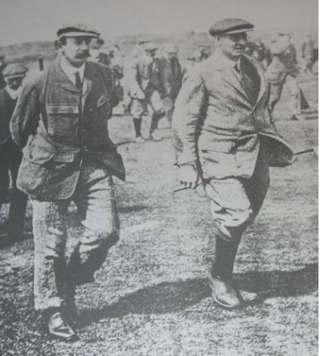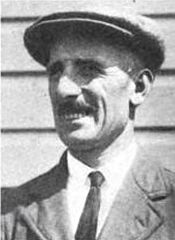
Henry William Vardon was a professional golfer from Jersey. He was a member of the Great Triumvirate with John Henry Taylor and James Braid. Vardon won The Open Championship six times, and also won the 1900 U.S. Open.

Alexander Herd was a Scottish professional golfer from St Andrews. He won The Open Championship in 1902 at Hoylake.

Edward Rivers John Ray was a British professional golfer, one of the leading players of the first quarter of the 20th century. He won two major championships, the Open Championship in 1912 and the U.S. Open in 1920, and contended in many others. He was captain of the British team in the inaugural Ryder Cup, in 1927.
The British PGA Matchplay Championship was a match play golf tournament that began in 1903 and ran until 1979. Between 1903 and 1969, the event was sponsored by the now defunct British newspaper the News of the World, and was commonly known by the paper's name. Initially organised as the championship of British professionals, the event came to include invited players from other countries – in particular from around the Commonwealth. On occasion, American professionals also took part, notably in 1949 when eight members of the victorious U.S. Ryder Cup side accepted invites to the event, Lloyd Mangrum reaching the semi-finals.
The Tooting Bec Cup is a trophy currently awarded by the Professional Golfers' Association of Great Britain and Ireland to the association member born in, or with a parent or parents born in, the United Kingdom or Republic of Ireland who returns the lowest single-round score in The Open Championship.
The 1911 Open Championship was the 51st Open Championship, held 26–30 June at Royal St George's Golf Club in Sandwich, England. Harry Vardon won the Championship for the fifth time in a playoff over Arnaud Massy, the 1907 champion.

Tom Williamson was an English professional golfer who played in the early 20th century. Williamson finished in the top 10 in the Open Championship on six occasions and played in it over fifty years. His best performance came in the 1914 Open Championship when he tied for fourth place, six shots behind the winner. With Harry Vardon he won the 1913 Sphere and Tatler Foursomes Tournament by a convincing 7 & 5 margin. He was Captain of England in 1909 and represented England between 1904 and 1913. He won the Midland Professional Championship when it was first held in 1897 and a further six times. He was a renowned club maker and was the first to number clubs in 1906. He experimented with score cards placing a course plan on the reverse side in 1930. He designed sixty courses, the majority in the East Midlands. He was a founder member of the PGA and became its Captain in 1928. He had a good reputation as a teacher and taught Enid Wilson who won the English Ladies Championship three times. He was known as a modest man of integrity.
Rowland Thomas Jones was an English professional golfer who played in the late 19th and early 20th century. Jones had two top-10 finishes in the Open Championship. His best performance came in the 1905 Open Championship when he finished tied for second place.
The Sphere and Tatler Foursomes Tournament was a professional golf tournament played annually from 1911 to 1914. Total prize money was £350 provided by the owners of The Sphere and The Tatler. The winners received individual silver trophies. It followed a similar format to that used for the popular News of the World Matchplay except that it was a foursomes event rather than singles.

The Leeds Cup is a golf tournament that has been played annually in northern England since 1902. The event is organised by the north region of the Professional Golfers' Association. It is the oldest trophy in professional golf that is still played for. The Tooting Bec Cup is older, having been first played for in 1901, but is no longer contested.

Bertie Snowball was an English professional golfer who played in the early 20th century. He was at his peak as a player from 1904 to 1908 but was still competitive as late as 1914. He was killed in 1915 during World War I.

James George Sherlock was an English professional golfer. He had four top-10 finishes in the Open Championship, including a sixth-place finish in 1904. In his long golf career, he had at least 16 professional wins. He played for the British team against the United States in the 1921 Ryder Cup match at Gleneagles.
The England–Scotland Professional Match was an annual men's professional golf competition between teams representing England and Scotland. It was played from 1903 to the start of World War I and was then revived in 1932 and played until the start of World War II. The match was played on a single day, generally a few days before the Open Championship. Except on one occasion, there were 12 players in each team who played 12 singles matches and 6 foursomes. Scotland won the inaugural match in 1903 but didn't win another match, although three matches were tied. The event was organised by the PGA and only members of the PGA were eligible to play.
The 1906 News of the World Match Play was the fourth News of the World Match Play tournament. It was played from Tuesday 2 to Thursday 4 October at Notts Golf Club. 32 players competed in a straight knock-out competition, with each match contested over 18 holes, except for the final which was over 36 holes. The winner received £100 out of a total prize fund of £240. Sandy Herd defeated Charles Mayo 8 & 7 in the final to win the tournament.
The 1913 News of the World Match Play was the eleventh News of the World Match Play tournament. It was played from Tuesday 7 to Thursday 9 October at Walton Heath Golf Club. 32 players competed in a straight knock-out competition, with each match contested over 18 holes, except for the final which was over 36 holes. The winner received £100 out of a total prize fund of £400. George Duncan defeated James Braid 3 & 2 in the final to win the tournament. This was Braid's fifth final but the first time he had been beaten.
James Benjamin Batley (1876–1964) was an English professional golfer. His main successes came in foursomes events, winning the 1909 London Professional Foursomes Tournament and the 1914 Sphere and Tatler Foursomes Tournament. He played for England in the 1912 England–Scotland Professional Match.
Harry B. Simpson was an English professional golfer. He finished third in the 1914 Open Championship.
Thomas William Simpson (1877–1964) was an English professional golfer. He had two top-10 finishes in The Open Championship, in 1905 and 1908.
Michael Moran was an Irish professional golfer, the leading Irish golfer of his generation. He won the Irish Professional Championship five years in succession from 1909 to 1913 before moving to England and being ineligible to compete in 1914. He played in the Open Championship from 1909 to 1914 with a series of high finishes. He finished joint third in 1913 despite a disastrous 89 in the third round which included a 10 at the first hole. He died in France in 1918 at the age of 31.
The Midland Challenge Cup was an annual professional golf tournament played in the English Midlands. The event was organised by the Midlands Region of the Professional Golfers' Association and ran from 1903 to 1961. For most of its existence it acted as the Midland section qualifying event for the News of the World Match Play. Sectional qualification was discontinued after 1961 and the event was not held again.





